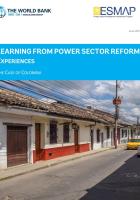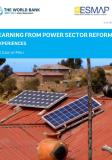Publications
In the early 1990s, Colombia’s publicly owned power sector was financially distressed and poorly managed, becoming a risk for the country’s macroeconomic stability. The sector reached a tipping point during extensive demand rationing episodes in 1992. Amidst the paradigm transformation promoted by the 1991 Constitution, Colombia launched an ambitious power sector reform package in 1994, introducing private sector participation, independent regulation of distribution and transmission, and competition in power generation and retailing. Aversion of demand rationing meant that early regulation and privatization efforts focused on the generation segment. Distribution privatization and unbundling proved more difficult and stalled shortly thereafter, preventing Colombia from fully implementing the announced reform package.
As progress was slow, in the 2000 decade a new firm-energy market was introduced to ensure security of supply, and distribution regulation revamped. Reforms have been successful in many aspects such as the absence of demand rationing, improving efficiency and financial viability of the sector, attracting investment in power generation, and improving average quality of service for final customers. However, disappointment emerged again due to weaknesses of the firm-energy market unveiled during the 2016 El Niño event, slow adoption of non-hydro renewables, steady tariff increases, and poor performance of several distribution utilities.



